Streets for People / Airport Expansion Means Fewer Cars on Our Island
Recent stories by two of the island’s favorite news sources Gwen Filosa and Nancy Klingener, brought us news (here and here) that the Key West International Airport has already set a record for annual passengers, surpassing 1 million for the first time ever and the year isn’t even over. They also shared that the County has started an $80 million expansion to build a new concourse to handle the overcrowding of the departure and arrival areas.
The stories, widely shared and commented on via social media, were met with the usual weeping, and gnashing of teeth. Some decried the lost innocence of the quaint architecture and cozy confines of the existing structure to be replaced with a modern, spacious glass box. Others complained that more airplanes mean more noise. Most seemed to bemoan a paradise lost to ever more visitors.
Okay, we get that it’s kind of cool to walk off your plane onto the tarmac because it adds to the “remote island” feel of Key West (HT: Jamie Mattingly). I like it. But the airport expansion is a good thing because it means travelers aren’t coming by car. Fewer cars mean less traffic congestion and parking problems downtown which enhance the experience for visitors AND residents. It is also better for business. Win. Win. Win. Let’s dive into some numbers on why this is so…
Airport Expands to Accommodate More Passengers
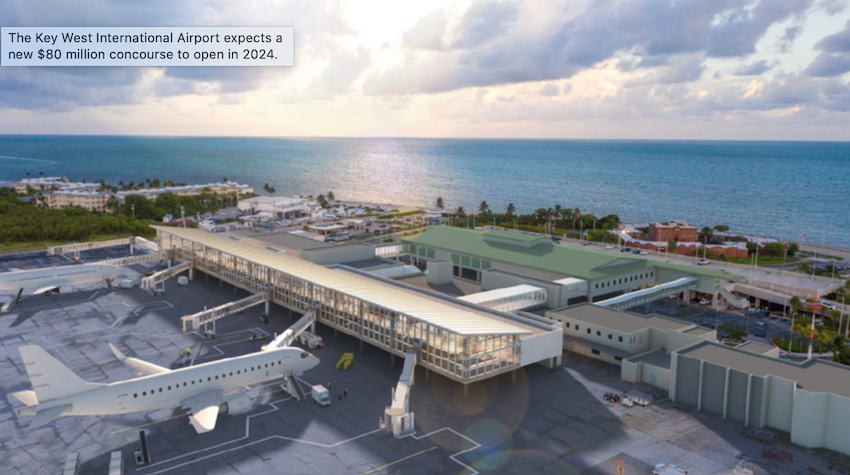
Richard Stickland, Monroe County Director of Airports recently outlined an $80 million new concourse that will open in 2024. It will include a new security checkpoint, new gates, a new “hold room” for departing passengers, new concessions, a new baggage claim area and glass-enclosed jet bridges, or jetways, to connect the planes with the building. He told Keys Weekly in May:
“There will be much more space to spread out and the new design overall will enhance the customer experience and the services we can provide. People won’t all be crunched together and on top of each other while waiting to depart or while waiting for their baggage. It’s the right amount of facility for the projected numbers of passengers we’re dealing with.”
We’ve seen many social media posts of people complaining about overcrowding at the airport. The recently announced passenger numbers setting a record of 1 million passengers with three and a half months to go in the year and a possible 1.5 million by year’s end undergirds the County’s decision to expand the airport facilities to accommodate the crush.
Traffic Congestion a Top Concern for Decades
As we’ve noted in many of our Streets for People stories, one of our favorite things to complain about on the island is traffic and parking. It seems to have been a major concern for a couple decades now. In her 2019 “Toward Car-Free Key West”; Journal of Transportation Demand Management, University of South Florida study, researcher Mary Bishop cited traffic congestion concerns as “well documented” in a 2004 citizen survey where 58% of residents ranked it number one among quality-of-life concerns. She also noted a 2015 City-sponsored survey ranked it number three behind affordable housing and the cost of living. More recently in a January 2021 Key West Community Survey of residents conducted as part of the Key West Forward Strategic Plan, only affordable housing ranked lower than traffic and parking on a list of 18 rates issues.
So having visitors arrive by means other than a car is a good thing.
Tens of Thousands of Cars Arrive on Our Little Island
According to the County’s latest 2020 TDC Visitor Profile Survey, 77 percent of visitors to the Keys arrived by car. 42 percent arrived in a personal car, 28% in a rental car and 7% flew into Miami and then rented a car. 20% flew into Key West and 2% flew into Marathon. Less than 1% come in by ferry and bus. Mary Bishop citied an 82% arrive by car number in 2013 in her research.
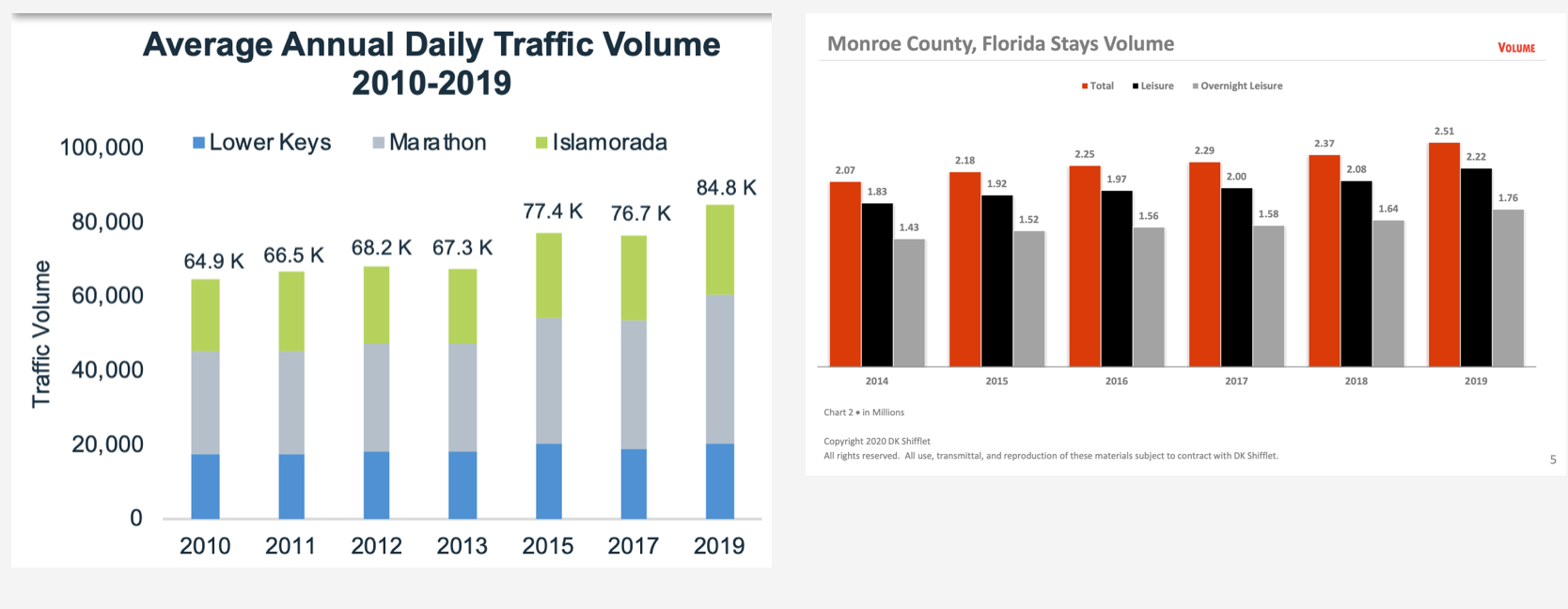
On a base of 2.5 million stays to the Keys (2019 Monroe County Visitor Volume and Spending; DKS Shifflet) that’s a lot of cars. We regret that we can’t be more precise about the driving numbers to the island of Key West, as the Visitor Profile Survey and Visitor Volume and Spending reports don’t break out travel by destination, even though they do break out other things like length of stay. We also regret that the TDC only shows the latest report of each kind, so we can’t line up the years or explore past data. However, the Key West International Airport (EYA) Visitor Analysis, March 2021 says that of those that drive, 52% make it all the way down to the Key West. The report also gives us Average Annual Daily Traffic Volumes of 84,000 Keys-wide with what looks like about 20,000 daily in the Lower Keys (see chart). This gives us a better idea of volume as it is less than the 77% number, but that’s still not enough information to adequately extrapolate the numbers of cars arriving here as we don’t know how many people are in each car.
One could say 2.5 million visitors x 0.52 arriving in Key West by car = 1,300,000 visitors arriving by car. If we average 2 persons per car that’s 650,000 cars or 12,500 a week. If the average is 3 that’s still 433,000 cars or 8,399 cars a week. We only have 3,000 metered, free, and Resident on street spaces downtown. That’s a crunch. We need better stats. We’d welcome some help.
So, while it is safe to say that for visitors who stay overnight in Key West, that there is less travel by car than the Keys overall because the airport and ferry are located here, we just can’t be more precise with the actual volume of cars crossing the Cow Key Bridge onto our island. We hope in the future, the TDC would consider more breakouts of the numbers in their reports so we can be more accurate in our reporting.
Regardless, the point is that it is still a huge volume of cars and that’s why for the past couple of decades traffic and parking problems continue to top the list of local’s complaints.
Airport Visitors Stay Put in Key West, Stay Longer, Spend More and Don’t Drive
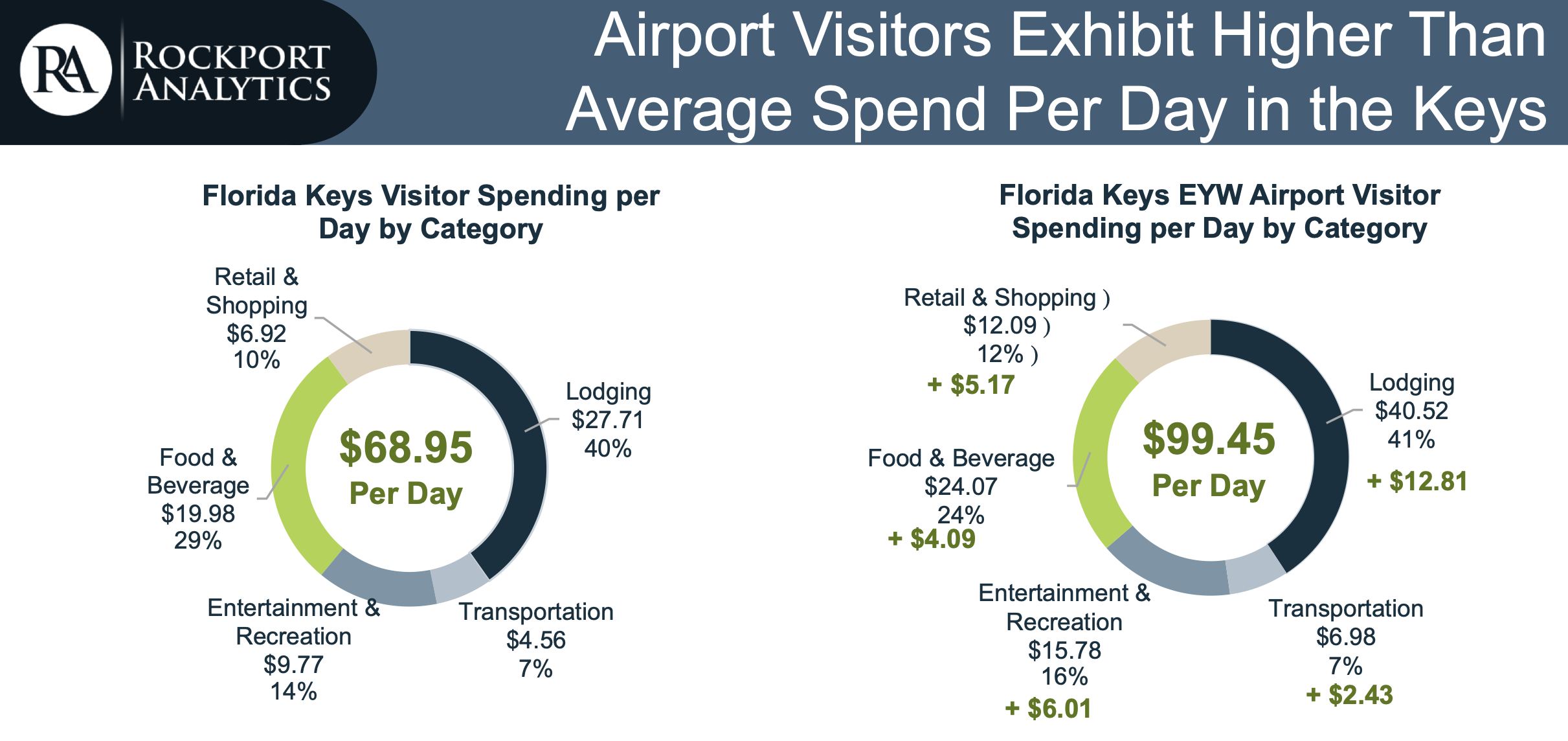
Here’s the key takeaways as reported in the excellently presented and easy-to-read Airport Visitor Analysis:
- From a tourism development standpoint, EYW airport visitors are attractive because they are spending more per day in the Keys and place less demand on the road and bridge infrastructure of the region.
- Almost 90% of airport visitors stayed in Key West vs 52% of visitors using other forms of transportation.
- While the increased service to EYW should help relieve pressure on the road and bridge infrastructure, the biennial traffic assessment study from Monroe County and the Florida Department of Transportation shows that passenger volumes rose, and travel delays increased between 2017 and 2019. Further expansion of EYW service in 2021 could offer some additional relief.
- Almost nine in ten visitors who travel through EYW airport stay in Key West. Those that fly into the Key West International Airport are significantly less likely to travel up the island chain and put additional stress on infrastructure. Of those flying into EYW, 2% took accommodation in the Lower Keys, 5% stayed in lodging in Marathon, 2% stayed in a property in Islamorada and 2% stayed in a property in Key Largo. Those who traveled to the Keys through other means (e.g., rental car, personal vehicle), on the other hand, are more likely to travel down the island chain with 16% taking accommodation in Key Largo, 13% in Islamorada, 17% in Marathon, 2% in the lower Keys and 52% in Key West.
- Visitors who fly through EYW airport spend an average of $99.45 per day, this is about $30 (44%) more than visitors who arrive using other forms of transportation.
In the Toward Car Free Key West study, we learn that: “Of those arriving to the Key West Airport, 67% answered that they did not use a car at all during their visit. For the Key West Express ferry terminal arrivals, 78% answered that they did not use a car at all during their visit.”
Much has been made of the lack of spending by cruise ship passengers. What the data shows is that people who travel by air spend more money than people who drive, take the ferry, or come by cruise ship. They also stay longer and stay here in Key West, so aren’t spending money up the Keys. And most don’t get a car rental. This is all good news for our island.
Repeat Visitors Use Cars Less with Each Visit
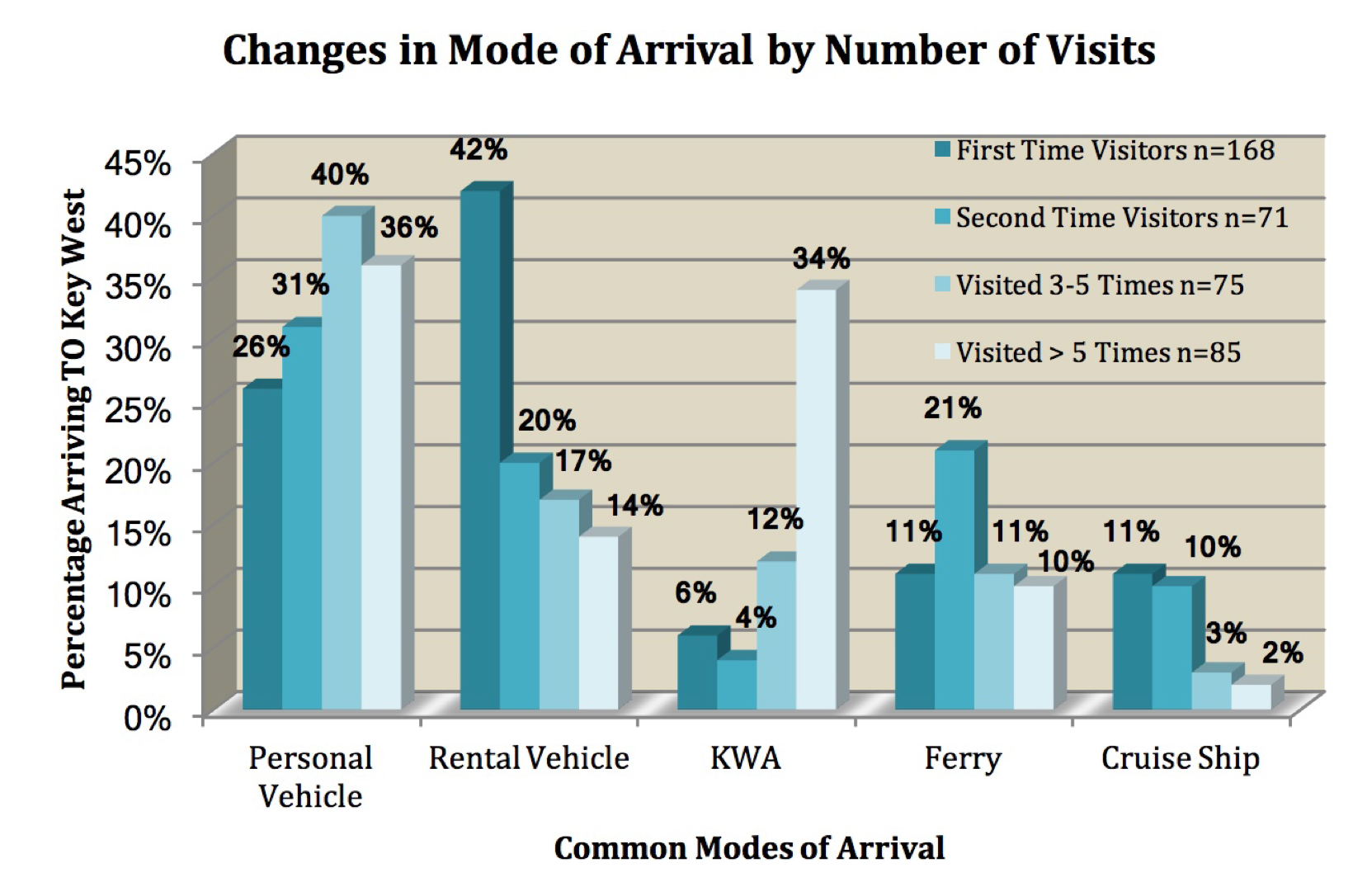
One of the Key takeaways from Mary Bishop’s research is something many of us may have come to known anecdotally, but she gathered the numbers to back it up. The takeaway is that once you are here on the island of Key West you don’t really need a car to get around. AND that once visitors experience Key West, the lightbulb goes off, and they understand this too. This is borne out in the fact that they tend to rent cars less and use the airport more on subsequent visits. Here’s how Ms. Bishop explains it:
“There is substantial evidence from this survey data to indicate that a vehicle is not needed once visitors arrive on the island. In total, 49% of visitors reported walking as their primary form of transportation while visiting and 32% reported not using a vehicle at all during their stay. The lack of need for a vehicle can also be indicated by the changing trends with repeated visits. While 42% of first-time visitors rented a vehicle for their stay, the percentage dropped to 20% by only the second visit. Meanwhile, arriving via the Key West Airport (67% of airport arrivals did not use a car at all during their stay) became more popular over the number of visits, rising from only 6% for first-time visitors to 34% for visitors who had visited more than five times. These findings suggest the importance of determining what is needed to convey the knowledge of repeat visitors to first-time visitors.”
Market to First-Time Visitors: You Don’t Need a Car While You’re Here, So You May as Well Fly or Ferry
The first of Ms. Bishop’s four recommendations to conclude her report is to convey this knowledge that cars aren’t necessary on the island to first time visitors as they are making their trip planning decisions via marketing. Certainly, the TDC’s marketing could do more of this. But the TDC markets the entire Keys and the only way to see the entire Keys is by car. So mostly we get marketing from the TDC that touts the wonders of driving the Overseas Highway. Once people bring a car into Key West, they tend to use it. So perhaps the Chamber, the Business Guild and the local Key West lodging and attractions community can do a better job of pushing a car-free experience, so people don’t rent cars. And the TDC can target Key West specific ads with the message.
And for people who drive personal vehicles, perhaps we can do more to promote airplane and ferry travel, which are recommendations two and three of the study.
If More People Are Visiting, It’s Better They Don’t Drive Here
More people are coming to Key West, and if they arrive by airplane, it is good for our economy because they stay longer and spend more per day. It helps reduce horrendous congestion on U.S. Route 1 throughout the Keys. And it helps alleviate traffic and parking problems on our island. Just imagine if the additional 500,000 visitors arriving at the airport this year vs 2019, were to get here by driving instead? We’d have to pave over paradise to accommodate them. So, let’s embrace the airport expansion as a good thing.
In a follow-up article we intend to explore more deeply the numbers in all these reports and how we can accomplish the recommendations in the Toward Car-Free Key West study. Stay tuned…
# # #
Research Reports:
- Toward Car Free Key West by Mary Bishop University of South Florida
- Key West International Airport (EYW) Visitation Analysis-DRAFT 3-24-21 (1)
- 2020 TDC VPS County Wide ANNUAL Summary FINAL 03242021
- 2019 Monroe County Volume and Quarterly Seasonal Travel Shares SD
- Key West’s Airport Hit a New Record with Passengers. But It Has Brought Problems; by Gwen Filosa, September 16, 2021
- Key West Airport Numbers Are Flying High and a Fix Is En Route – ETA: Three Years; by Nancy Klingener, September 15, 2021
- Key West Airport Readies for $80M Upgrade; by Mandy Miles, May 3, 2021
You can find all the KONK Life Streets for People column articles here and recent stories below:
- Reimagining Key West – 10 Goals for a Better Future and 10 Actions to Get There; September 17, 2021
- Serious Bikeshare in the U.S.A. is 11 Years Old. Its Success Shows Cities Can Do Innovative Work; September 10, 2021
- Can We Save Key West Transit from a Death Spiral? September 3, 2021
- We Need to Increase the Quantity and Quality of Bicycle Parking Downtown; August 27, 2021
- City to Make It Easier to Bike to the Lower Keys Shuttle Bus; August 20, 2021
- It’s Time to Put an Hourly Limit on the Free On-Street Parking Spaces and Institute a Zone System for Residential Parking Permits Downtown; August 13, 2021
- We Need to Encourage Efforts Like the Proposed Lama Electric Scooter; August 6, 2021
- Uber-Like Transit Coming to Key West?; July 30, 2021
- Our Top 7 Bike, Walk, Transit and Streets for People Articles of 2021; July 24, 2021
- With the Duval Street Revitalization Plan Way Behind Schedule, Here’s 3 Quick Wins for Pedestrianizing Duval Street Now; July 16, 2021
- Limiting Large Cruise Ships Gives Us an Opportunity to Make Duval Street and Historic Downtown More Locals Focused, Again; July 9, 2021
- Mayor Bravely Puts Onus on Commission to Do Heavy Lifting on Bike, Walk and Transit. Will They Come Through?; July 2, 2021
- Monorail, Monorail, Monorail or Just Say No to Privatizing Key West Parking; June 25, 2021
- New City Manager Will Be Good for Bike, Walk, Transit and for Key West; June 18, 2021
- PeopleForBikes Ranks Key West 39th Best City for Bicycling; June 11, 2021
- First and Bertha Streets Corridor Road Improvements Are Another Missed Opportunity to Make Bicycling Safer and Easier; June 4, 2021
- Want Sidewalk Cafe’s and Other Amenities? We Need to Take Some Space from Cars; May 28, 2021
- In Quest to Improve Crosstown Greenway, City Prepares to Construct New Bike Trail Segment; May 21, 2021
- How Better Transit and Bicycle Facilities Can Help Address Affordable Housing; May 14, 2021
- City Commission Tries to Have Its Cake and Eat It Too on S. Roosevelt Blvd. – Perhaps Dooming a Safer Project; May 7, 2021
- What’s Old is New Again – Two New Bike Trails Take Us Back in Time to a Simpler Key West, April 30, 2021
- Do Key West Commercial Areas Need Business Improvement Districts (BIDS)? – Part 2: What BIDS in Key West Might Look Like, April 23, 2021
- Do Key West Commercial Areas Need Business Improvement Districts (BIDS)? – Part 1: What’s a BID?; April 16, 2021
- The Good, the Bad and the Ugly – A Dozen Marketing Things KW Transit Can Do to Increase Ridership; April 9, 2021
- The Sorry State of Key West Bus Stops – We Just Don’t Care; April 2, 2021
- It’s Time to Reconsider a Road Diet on S. Roosevelt and Make the Promenade and Road Safer; March 26, 2021
- Getting the Parking Right Leads to Streets for People – Part 2: Battling Our Inner George Costanza – Ten Things We Can Do in Downtown Key West to Get the Parking Right; March 19, 2021
- Getting the Parking Right Leads to Streets for People – Part 1: Nobody Goes there Anymore. It’s Too Crowded – Six Reasons for Right Pricing Parking; March 12, 2021
- Eight Things We Can Do to Pedestrianize Duval and Still Allow Cars, March 5, 2021
- How We Get Wider Sidewalks Downtown Without Ripping Up the Streets – Parklets; February 26, 2021
- The Wee Donkey, Whataboutism, Bathwater and Duval Street’s Future; February 19, 2021
- Averting E-Bike Mayhem and Making Key West Sidewalks Safer; February 12, 2021
- Sustainability Board Wants to Make Free, Frequent and Simple Key West Transit a Reality, February 5, 2021
- Volunteers and a Little Green Paint Show How We Can Make it Safer to Bike; January 29, 2021
Chris Hamilton is founder of the local advocacy group Friends of Car-Free Key West & Duval Street/Historic Downtown. He’s a native of the District of Columbia, where for a couple decades+ he led nationally renowned efforts promoting transit, bike, walk and smart growth for Arlington County, VA’s DOT. Chris has lived in Key West since 2015. He lives downtown and works and volunteers for a couple non-profits.
[livemarket market_name="KONK Life LiveMarket" limit=3 category=“” show_signup=0 show_more=0]


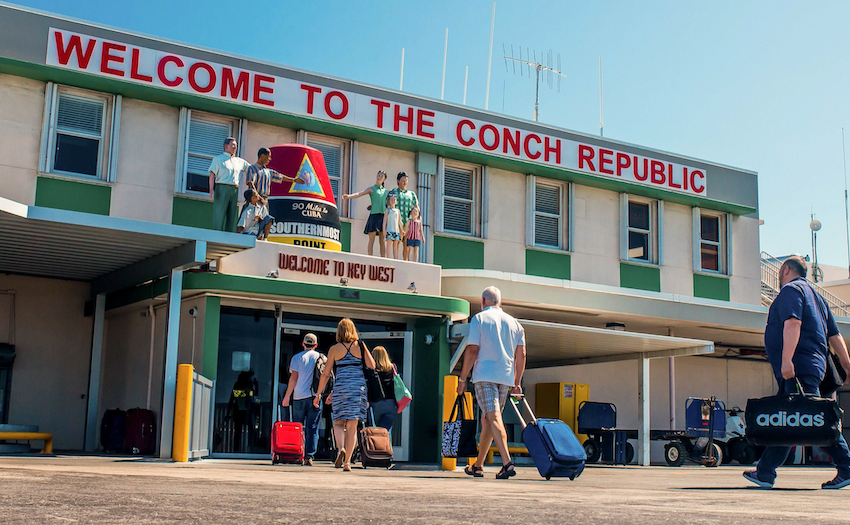


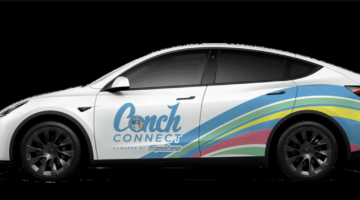
Excellent reporting. I question the dollar amounts spent for lodging: $30/day in general, $41/day for fly-ins. At an average of two people per room, that is still far less than the current average of around $300/day per room. Do these low numbers mean that most visitors stay in Air BNB homes in groups of ten? Also, the low dining numbers would mean most are buying their own groceries. I’d love to see the raw data that Rockport Analytics used to come up with these averages.